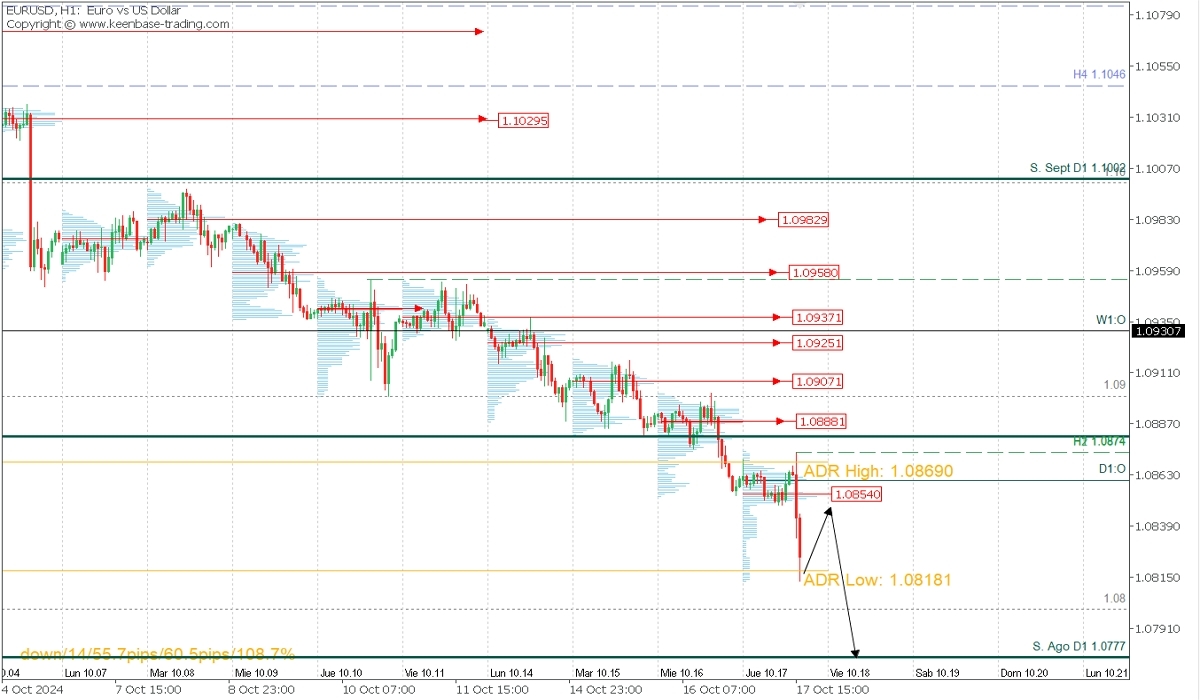Fundamental Analysis
The euro (EUR) has maintained a bearish trend following the European Central Bank (ECB) decision to cut interest rates by 25 basis points, bringing the deposit rate down to 3.25%. The low inflation rate in the Eurozone, which dropped to 1.7% in September, has further increased pressure on the currency, with EURUSD falling to its lowest level in two months.
The ECB's dovish policy contrasts with the strengthening of the U.S. dollar (USD), driven by strong economic data from the U.S., such as September retail sales growth and low unemployment rates, which support the Federal Reserve’s more hawkish stance.
In contrast, the BoJ maintains its interest rate at 0.25% and continues with an accommodative policy. Japan's inflation stands at 3%, which reduces the pressure for an immediate monetary adjustment, keeping the yen (JPY) strong against the euro.
Technical Analysis
EURUSD, H1

- Supply Zones (Sells): 1.0854 and 1.0888
- Demand Zones (Buys): 1.08
The pair extends its bearish sequence due to the ECB's recent monetary easing and following the strong economic data from the U.S.
The price decline during the U.S. session, which reached the daily bearish average range at 1.0818, left a supply zone around 1.0854, likely to be revisited for more selling liquidity. This downward move validated the 1.0874 level as the last intraday resistance, implying that the bearish trend will remain intact as long as the next retracement stays below it. Once the next retracement towards at least 1.0850 is complete, a further drop towards 1.08 and August’s support at 1.0777 is expected in the short term.
Technical Summary:
- Buys above 1.0818 with TP at 1.0850 or 1.0854 as an extension. Use a 1% SL of your capital with a low lot size to allow price movement.
- Sells after a pullback below 1.0854 with TP at 1.08 and 1.0777 as an extension. Use a 1% SL of your capital.
EURJPY, H2

- Supply Zones (Sells): 0.5835, 0.59, 0.5654, and 0.6049
- Demand Zones (Buys): 0.5773, 0.5690, and 0.5646
The pair is in a macro consolidation below August’s resistance after a sharp drop in July, which reversed the macro trend to bearish. Currently, a triple top chart pattern is forming, and confirmation after a decisive break of the 161.90 support will allow for renewed bearish momentum towards the next demand zone at the uncovered POC* at 161.30 and the daily bearish range, opening the door for a further drop towards 160.00.
This scenario will be invalidated if prices surpass the supply zone around 162.60 and 163.00, targeting the highs of the chart pattern at 163.57.
Technical Summary:
- Sells below the 162.31 support with TP at 161.30, 161.00, and 160 as an extension. Use a 1% SL of your capital.
- Buys above 161.30 with TP at 162.00, then looks to continue selling. Use a 1% SL of your capital with a low lot size to allow price movement.
Always wait for the formation and confirmation of a Reversal Exhaustion Pattern (REP) on the M5 timeframe before entering trades in the key zones we’ve outlined, as taught in our Telegram Spanish channel here
*Uncovered POC: POC = Point of Control. It is the level or zone where the highest volume concentration occurred. If it previously triggered a bearish move, it is considered a selling zone (resistance). Conversely, if it triggered a bullish impulse, it is considered a buying zone (support).
@2x.png?quality=90)



